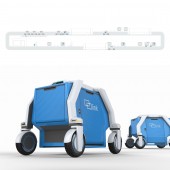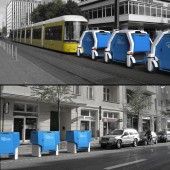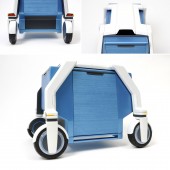DESIGN NAME:
link_urban logistics
PRIMARY FUNCTION:
Urban Logistics
INSPIRATION:
One of the challenges we are facing this century is urban mobility, especially the distribution of goods in cities. Todays logistics consist of too many trucks that drive around unorganized, unsynchronized and are not even fully loaded. This situation has grave impact on the city and the environment.
The goal was to reduce urban truck movement and propose a sustainable, seamless alternative.
UNIQUE PROPERTIES / PROJECT DESCRIPTION:
Link is a synchronized urban logistics system that makes use of existing public transportation infrastructure and enables regional distribution.
It is a network of robotic cargo transporters that connect consolidation centers with neighborhood storage spaces. By following buses and trams the electric robotic vehicles navigate through the city without interfering traffic. This network shortens distribution distances, thereby reducing the need for trucks and opening delivery alternatives for the last half mile.
OPERATION / FLOW / INTERACTION:
The system uses bus and tram depots in the outskirts as consolidation centers. Cargo arriving to the city is sorted according to areas and loaded on transporters. Using smart technologies, the robotic vehicles follow buses and trams from the centers to local storage spaces, located near bus stops. In these hubs the vehicles autonomously replace their loaded containers with empty ones and return to the depots to be reloaded and sent out again. The containers in the hubs act as temporary storages. Since the distances have been shortened, the last 100 m is made by a delivery man on foot, bicycle, etc.
PROJECT DURATION AND LOCATION:
The project started in December 2012 in Berlin and finished in October 2013.
This project was my Master thesis project and was presented in Berlin.
|
PRODUCTION / REALIZATION TECHNOLOGY:
My design process began with theoretical and field research. This allowed me to set targets and goals for the project. I continued the design process using sketches, prototypes, functional models that allowed me to define and refine the concept and the design. During the process I met with experts in the field such as the director of the DHL Future Cities Lab. The project was finalized with a presentation, scenario animation and 1 to 5 scale model.
SPECIFICATIONS / TECHNICAL PROPERTIES:
The link vehicles have a loading capacity of 3.0 m3 and the rough dimensions of a smart car. They are symmetrical and their wheels turn 360 degrees allowing multiple driving directions. The vehicles can maneuver in the narrowest space. The wheel forks rotate eccentrically, lifting and lowering the structure and container to place the containers on the hub bases. The bridge like structure connects and disconnects from the container when necessary and enables free movement over the containers.
TAGS:
robot, logistics, urban logistics, mobility, cargo transporter, regional distribution
RESEARCH ABSTRACT:
The research consisted of theoretical and field methods. I researched the history of the field, up to date statistics, technologies and existing approaches. I conducted surveys with shop owners that led to surprising insights about current urban logistics. I met with leading experts from the field such as the program director of City Logistics DHL. I consulted city planners and engineers in order to create a plausible, realistic system. I explored scenarios and designs using various techniques.
CHALLENGE:
One main challenge was integrating a new form of transport system into the urban infrastructure without interfering with its smooth flow. The system consists of various elements (vehicle, hub, container) that influence each other and combine different design aspects such as street architecture, transportation and product. Taking these aspects into consideration while at the same time trying to keep each one as efficient as possible was a great design challenge.
ADDED DATE:
2014-01-29 07:22:17
TEAM MEMBERS (1) :
Ayelet Fishman
IMAGE CREDITS:
Ayelet Fishman, 2013.
|










